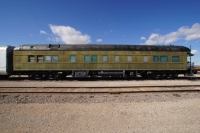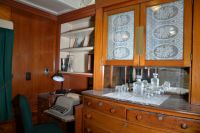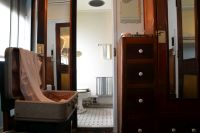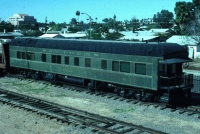SOUTHERN RAILWAY
Business Car “Desert Valley”

|
SOUTHERN RAILWAY Business Car “Desert Valley” |
 |
| Listen Here |
This car provided transportation for railroad officials when traveling on company business.
It was built in the Charleston shops of the South Carolina Railroad in 1879, and was acquired by the Southern Railway in 1899. It has two bedrooms, crew quarters, a dining room with full galley, and a six seat lounge. In 1924 ice air conditioning was added, and the wood sides received steel sheathing. The car accommodated two officials, a secretary, and a crew of two. It also served as a payroll distribution car.
After its retirement in 1967 it was acquired by several private owners, then in 1982 by museum member Russ Joslin who named it "Desert Valley." It arrived in 1989, and his family donated it in 1995.
When the South Carolina Railroad became the South Carolina & Georgia Railroad, the car was numbered 101 until merging with the Southern Railway in 1899. It then went through several changes to number 115, then number 111, then number 11 in 1912. It changed again to number 9 in 1920, and to number 6 a year later. The varying numbers were the result of changing seniority in the office car fleet, company numbering policies, and occasionally the preference of the officer assigned. It was variously headquartered in Salisbury and Greensboro, North Carolina; Atlanta and Washington DC; and finally Knoxville, Tennessee in 1935.
This 73-foot car was originally of all wood construction. In 1924, a steel underframe and steel side sheathing were added at the company shops in Knoxville, and eventually it gained ice air conditioning and a metal covering over its clerestory roof. It received its final Southern Railway number 16 in 1946.
The Southern Railway once served the southeastern states of Virginia, North and South Carolina, Georgia, Florida, Alabama, and Mississippi, with side routes to Kentucky, Indiana, and Illinois. It also reached Washington DC, Cincinnati, St. Louis, and New Orleans. It was merged into the Norfolk Southern Railway in 1982.
After its retirement in 1967, this car was purchased by the Houston Sports Authority, then was sold in the late 1970s to the Phoenix Cotton Pickery. (This cotton enterprise was on Hadley Street south of the Southern Pacific rail yard in Phoenix. Cotton is one of the five C′s for which Arizona is noted.)
Russ Joslin purchased it in 1982 and moved it to an unused Santa Fe Railway spur near 39th and Montecito Avenues, where he used it as a personal office. In 1989 the Santa Fe moved it to Phoenix, then the Southern Pacific delivered it to the museum′s temporary storage track near Pecos Road. After the Armstrong Park switch was installed in 1993, the museum′s Plymouth moved it onto the museum grounds at Erie Street in 1994. It was moved south by the now Union Pacific Railroad to the museum′s new Tumbleweed Park location on Ryan Road, along with the rest of the fleet, in 2006. (The Union Pacific acquired the Southern Pacific in 1996.)
Although heavily modified by the Southern Railway, it basically retains its original wood frame construction and its fully installed 32 volt DC electrical circuitry. Parallel wiring has been added to allow operation of the lights on 120 volt AC power.
At the time of this writing (late 2020), this is the oldest car in the museum. Its previous owner, Russell Joslin, passed away in 1993.
 |
12/21/2021 - View of the lounge area. |
 |
12/21/2021 - View of the Secretaries desk in the "office" / dining room. The typewriter is on a hinged shelf and can be folded away out of view when not needed. |
 |
View of the private bathroom/shower. Only accessible from the executive bedroom. |
| 2/27/2013 - Photo of car. | |
| Photo of dining room interior. | |
 |
Photo of lounge interior. |
 |
Photo of car at old ARM display yard. |
| Q1, 2016 Southern Railway Historical Association (10 page article in .PDF format). | |
| Car number chronology over the years. | |
| Roster of Executive Officers assigned to Southern #16. |